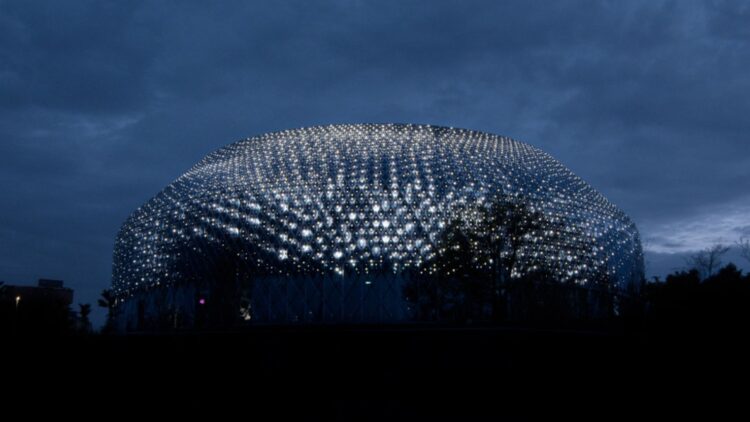Imagine the power that can be generated from 10,000 solar cells capable of producing energy. Now picture a building made up of 10,000 solar cells that is meant to generate energy. One such building, the Novartis Pavillon in Basel in Switzerland focuses on sustainability with a modern twist. This building makes use of approximately 10,000 diamond-like organic solar modules. The whole aim of this building being fully equipped with 30,000 RGBW LEDs is to ensure that the building lights up as a producer of just as much energy as it consumes. While looking at the modern building, impeccable glimpses of art and science are visible, but the sustainability promoted by this building remains hidden to the naked eye.
About the design of the Novartis Pavillion in Basel
The initial design was brought to life by AMDL CIRCLE that was headed by leading architect Michele De Lucchi. The building was further developed as per the collaboration with iart, a media architecture studio in Basel itself. The Norvatis Pavillion building is a building that is designated to the healthcare and life sciences sectors. While been a publicly accessible building the lure of the building lies in its ability to generate power and emit light.
An energy-neutral building
The Novartis Pavillion is a media façade that is energy neutral and visually captivating. As opposed to traditional media façades, this building does not consume too much electricity. In fact, it generates the energy that it needs to use.
Energy generation is a possibility due to organic photovoltaics (OPVs). Being carbon-based and lightweight, the building does not require all too much energy. The solar modules itself are highly adaptable and they can cover the donut-shaped structure effortlessly.
Every one of the 10,000 solar modules has LED units that point outward and inward provoking a dual lighting system. All of the solar panels work to capture light in the day which powers the building and, in the process, displays messages of scientific data. During the evenings, the façade changes into a digital artwork displaying numerous paintings. All the credit for the diplay paintings and the visual content displayed by this energy-neutral building needs to go to Novartis scientists in collaboration with Daniel Canogar, and Esther Hunziker. The entire building encapsulates the core premises of sustainability at its best.
Novartis Pavillion- more than a work of art
While the artistic architecture behind the Novartis Pavillion building deserves credit, the sustainable building technology is what needs to be applauded. Due to the multi-layered membrane acting like a communicative skin, the building gets connected to the broader public sphere tying in with the mission of allowing healthcare to become rather accessible.
The hope from the Novartis Pavilion media façade is to set a new vision of renewable energy and its use in architectural advances. The core crux behind the Novartis Pavillion, as has been stated by Valetin Spiess (founder of iart) was to ensure that while electricity was being consumed, it was simultaneously being generated. As a result, this media façade is not just a work of art but an architectural innovation that reduces environmental impact. While the spinning photovoltaic cone does defy logic, so too does this media façade.
Why the emphasis on this media façade?
Being a building that generates its own power and one that has surprised the design world, it is no wonder why this media façade has been shortlisted for the Dezeen Awards. Serving as a symbol of strength and a building the challenges conventional thinking and futuristic architecture and shows what can be a possibility from a sustainable architectural standpoint. The Novartis Pavilion is one building that shines out above the rest-both during the day and at night. With 10,000 solar molecules and record energy, it is no wonder why this futuristic design is shocking America.


